Trends in Higher Education Interiors
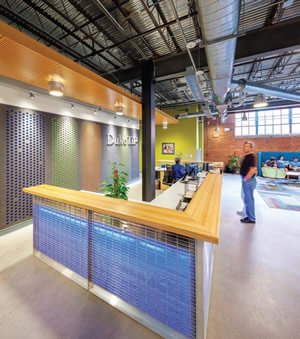
PHOTO © R H WILSON PHOTO
Duke University’s Talent Identification Program (TiP) incorporates the program’s brand identity colors with accent wall panels behind a custom reception desk. Wood accents warm up spaces in this repurposed former power plant.
Today’s college student is more attuned to design than ever before. Reared on a visual diet that includes commercial influences from Apple, Target and other design-savvy product manufacturers and retailers, they are looking for similar visual and functional experiences in the university environment. Having worked in the higher education market for over 25 years, LAMBERT Architecture + Interiors has seen the trend evolve away from typical institutional interiors. Gone are painted concrete block, terrazzo floors and 2-foot-by-4-foot lay-in ceilings with fluorescent lighting, and uncomfortable furnishings (if any) in common areas. Today’s interiors feature a broad range of finishes and furnishings, creating spaces that encourage students to linger and collaborate.
COLORS
We have noted an increase in requests to “brand” interiors. Many university athletic programs have had great success promoting support for their teams by intensive integration of school colors and logos into facilities and programs. Colleges and universities are aggressively marketing themselves to prospective students, and have realized that creating a strong connection can be assisted by the use of school colors and imagery. However, this approach is not without issues. Most school colors were chosen to be intense, and to be used on uniforms, banners and print materials. Over-eager marketing directors may insist on the use of the school’s exact matching Pantone colors for interior finishes. While this may work well for athletic facilities that receive only occasional use, it can be a bit extreme for interior spaces such as student centers, dining facilities and residential spaces that are used on a daily basis.
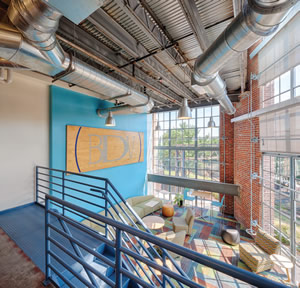
PHOTO © R H WILSON PHOTO
An actual portion of a basketball court floor is used as artwork at “basketball mad” Duke University. The carpet and fabrics selected reinforce brand identity colors of the TiP program in this flexible meeting area.
LAMBERT was called in to fix “branding gone bad” at the University of North Carolina Greensboro’s Elliott University Center. Initial efforts had used the university’s graphic standard colors of royal blue and intense yellow-gold for interior repainting. The results were not pleasing. Working with a committee that included Facilities, Marketing and University Center staff, a palette was devised that used the blue and gold as inspiration but softened the intensity. Neutral shades were used to fully repaint the interiors, and the school colors were applied as accents in featured locations. New carpet tile was selected in a manufacturer’s standard rectangular pattern with a range of deep blue shot with a streak of yellow. This was a lucky find and prevented the need for a custom color run, but when only custom colors will work, it is increasingly easy to specify colors using a manufacturer’s standard pattern for a relatively small, minimum-quantity run at little to no additional cost.
FURNITURE
Collaborative environments continue to be popular and everyone wants everything on wheels — everyone, that is, except for the staff responsible for maintaining the arrangement and inventory! Increasing options in mobile furniture have indeed done much to allow students and faculty to create configurations that foster a specific learning need or task. Strategies such as coding furnishings and upholstery in specific colors can be employed to identify distinct spaces. If a piece then “travels,” it’s easy for staff to recognize the odd item and get it back to its proper home.
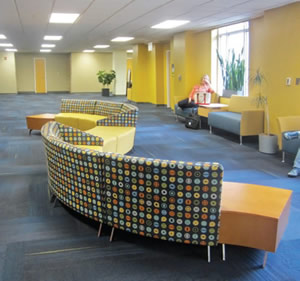
PHOTO COURTESY OF LAMBERT ARCHITECTURE + INTERIORS
School colors of royal blue and neon yellow-gold were toned down and used as accents in the interior redesign of the Elliott University Center at UNC Greensboro.
The top priority on user lists these days is integration of technology. The need to hardwire power and data connections can run counter to the desire for flexibility. Increasing speeds in wireless technology have eliminated most needs to have a hardwired data connection, but provision of power is still an issue. Battery life is improving, but students can still be found clustered around a power outlet. Many options now exist that allow power modules to be incorporated into tables and even soft seating units. Still, much coordination is required to understand and properly specify power connections to the furniture modules. Hardwired data connections can still play an important role in collaborative environments. Several systems allow users to plug their laptops or tablet devices into a console and share the work on a large screen and switch between users. With the increasing amount of material available online, libraries in particular are moving away from being warehouses for books and printed material. They are becoming digital learning centers where staff and systems are designed to help them find, sort and interpret the vast amount of reference materials out there. Furniture must accommodate both university-owned and controlled technology, while still accommodating students’ personal laptops, tablets and phones.
FABRICS
When it comes to choosing fabrics, the age-old struggle between comfort/aesthetics vs. durability/maintainability is getting easier. Whereas the designer used to need to choose between these, now you can have both. New vinyl choices come in a multitude of textures, many that look and feel like a fabric instead of vinyl. Some have self-healing capabilities that protect against concern of punctures from pencils or pens. There are even metallic and iridescent options. Vinyl continues to be a good choice for areas subject to high wear, such as the seat cushion.
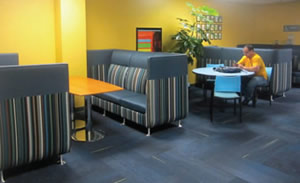
PHOTO COURTESY OF LAMBERT ARCHITECTURE + INTERIORS
Highbacked lounge seating is a popular way to create zones for group work or individual privacy.
In the UNC Greensboro Elliott University Center high-backed lounge furniture was used to create privacy for individuals or groups, but taken into consideration was the fact that students’ hair care products can cause unsightly staining in the “head zone.” Accent application of vinyl in this area provided an easily wipeable surface that would resist damage, and formed a nice design connection to the same vinyl on the seat cushions.
We still favor woven fabrics over printed for patterns, but a vast array of choices is available in both. Typically, look for options that exceed 100,000 double-rub ratings as a minimum. Fabrics made from stain-resistant impregnated fibers, such as Crypton or Nanotex, are tops for consideration in these highuse and abuse environments. When we really want to use a fabric from a design perspective that is not available in these fibers, we call for fabrics treated with a similar protective coating before it is applied to the furniture.
MATERIALS
Increased focus on aesthetics, coupled with a greater range of durable choices, has allowed a wider variety and more options for interior finishes. Another trend is authenticity; students are gravitating to designs that convey a sense of soul. Natural materials such as stone or weathered wood help bring a layer of history to a new or renovated space. The use of wood finishes is popular as a way to introduce visual warmth into spaces. New production technologies have allowed plastic laminates, ceramic tile and vinyl films on metal panels to be acceptable and often superior functional substitutes for wood.
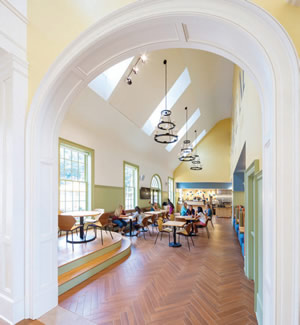
PHOTO © R H WILSON PHOTO
A narrow strip of bluestone forms a contrasting threshold at the arched entryway to the café in the Salem College Student Center. This allowed the use of natural wood in the lobby areas, but more durable wood-looking ceramic tile in the café to maintain visual consistency throughout.
In the new Student Center at Salem College in Winston-Salem, NC, the nation’s oldest institution for higher learning for women, the use of wood floors was important to maintain consistency with other buildings on campus, some over 200 years old. Rift-sawn oak was chosen, and durable new finish technologies allowed its use throughout major common areas. The café is a major component of the building, and the college wanted the wood flooring to continue in this area. After much deliberation, a wood-look ceramic tile was decided upon in a similar color and pattern to the real wood floors due to the high level of traffic, usage and cleaning in the café. Increased attention to sustainability has raised awareness of how and from where materials are sourced. The high visibility of finishes yields an obvious place to showcase materials made from renewable sources such as cork and bamboo.
As trends come and go, some of these ideas will fade away, but the increasing variety of color, material, furniture and interior finish options will only grow. We are excited to see where the future leads, and what choices are available next year and the next.
This article originally appeared in the issue of .